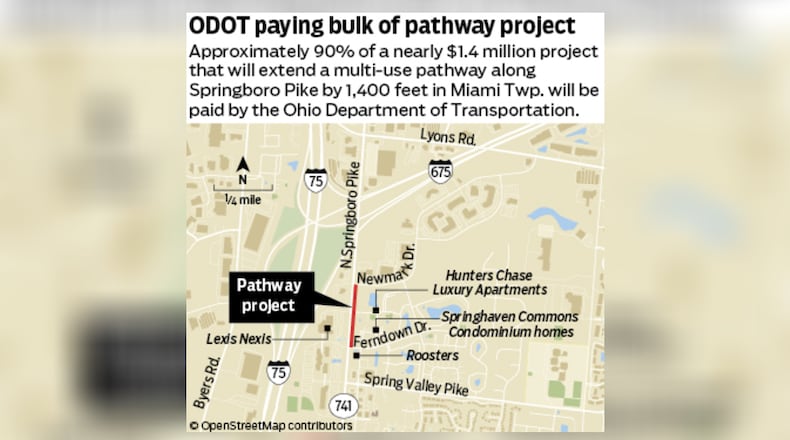“As this section of a heavily trafficked thoroughfare in our community has no pedestrian connectivity, this is a high priority project for Miami Twp.,” Carlson said. “The existing configuration of Springboro Pike does not allow adequate room for pathway on either side of the road.”
The 0.265-mile path, which will be 10-11 feet wide, is intended for use by both pedestrians and cyclists, Carlson said. The project was among 27 Ohio traffic safety projects recently announced, with $40.9 million in funding aimed at protecting pedestrians and preventing roadway departures in 21 counties.
The cost of the project — $1.37 million for a 0.265-mile path — stood out given the ongoing 3.6-mile repaving of Mad River Road in Miami Twp. and Kettering, for $892,000. The Mad River work is more than 12 times longer and twice as wide. Carlson said the cost difference “highlights the significant difference in construction involved.”
“Repaving a road like Mad River Road focuses only on the road surface itself,” he said. “While there may be some minor repairs or improvements to shoulders, the overall construction is far less complex.”
The total estimate for the project is $1,372,307, with ODOT providing funding for $1,231,892, covering nearly 90% of the total project cost, Carlson said. The cost includes construction, temporary right-of-way acquisition, engineering plans, new pedestrian signals and more, he said.
That section of the Springboro Pike Pathway Project in particular has several challenges, Carlson said. Due to the roadside grading and utility location, relocation of several utility poles and regrading must occur before a pathway can be constructed, he said.
“With the ultimate goal of connecting Ferndown Drive to Lyons Road, this is just the first section of a larger project that aims to create a dedicated, off-street connection all the way from Austin Landing to the Dayton Mall with direct, off-street access by thousands of homes,” Carlson said.
Funding for the projects comes from the Ohio Department of Transportation’s Highway Safety Improvement Program. The bulk of the funding goes to local government entities like municipalities, townships and county engineers.
“Our mission is to provide a transportation system that is safe, accessible, well maintained, and positioned for the future,” ODOT Director Jack Marchbanks said about the 27 new projects statewide. “However, safety shouldn’t be limited only to certain road types or locations.”
About the Author

